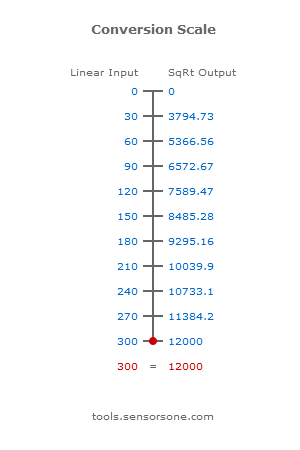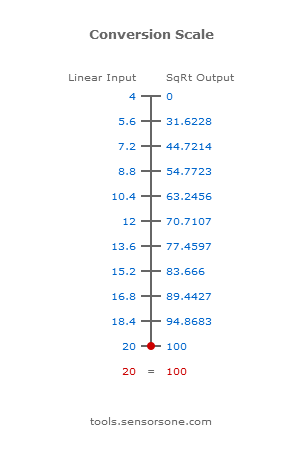Click save settings to reload page with unique web page address for bookmarking and sharing the current tool settings
Invert the low & high range limit settings for the input or output side
Flip tool with current settings to swap I/O parameters and/or apply a square root extraction if required
Related Tools
User Guide
This linear input to square root extraction output conversion tool provides an easy way to determine the ideal sqrt output produced by a measurement instrument for any given linear input value. A conversion scale for each specified linear input and sqrt extraction output range combination selected will be displayed below the calculated output.
Input
Input Unit
Enter the measurement unit associated with the input values.
Linear Input Reading
Enter the linear input measurement reading to be converted.
Lowest Linear Input
Enter the minimum possible value for the input range. The value can be a negative or a positive value and should be in the same engineering units as all Linear Input values.
Highest Linear Input
Enter the maximum possible value for the input range. The value can be a negative or a positive value and should be in the same engineering units as all Linear Input values.
Output
Output Unit
Enter the measurement unit associated with the output values.
Lowest SqRt Output
Enter the minimum possible value for the output range. The value can be a negative or a positive value and should be in the same engineering units as all Square Root Extraction Output values.
Highest SqRt Output
Enter the maximum possible value for the output range. The value can be a negative or a positive value and should be in the same engineering units as all Square Root Extraction Output values.
SqRt Output Reading
This is the ideal Square Root Extraction Output for the specified Linear Input Reading and excludes all measurement device errors and uncertainties.
Formula
SRO = (((LI - LLI)/(HLI - LLI))1/2 x (HSO - LSO)) + LSO
Symbols
- LI = Linear Input
- LLI = Lowest Linear Input
- HLI = Highest Linear Input
- SRO = Square Root Extraction Output
- LSO = Lowest Square Root Extraction Output
- HSO = Highest Square Root Extraction Output
Help
Linear to SqRt % span formula
What is the formula for converting a linear reading as percentage of span to a square root reading?
The formula is as follows:
%SqRtSpan = √ (%LinSpan/100) x 100
0-300 pascals dp to 0-12,000 cubic metres per hour flow conversion
We have a differential pressure of 0 to 300 pascals which is feeding a DP transmitter that sends a square root extractor input to a DCS system measuring a flow rate of 0 – 12,000 m3/hour. What flow rates should we expected to see at different pressures over the 0 to 300 Pa range?
The following conversion scale shows 10 points over the 0 to 300 Pa range for you to compare with actual flow being measured.

SqRt extraction to convert inH20 pressure to mmscfd flow
What is the exact calculation that is performed when we are selecting square root as a transfer function for flow measurement? For example, if 0-100 mmscfd (million standard cubic feet per day) is the flow range and 0-100 inH2O is the differential pressure sensor range. When the DP is 50 inH2O, the flow will be 50 mmscf if the linear range is selected. In the case of square root what will be the flow when the DP is 50 inH2O?
Using this formula the flow generated by 50 inH2O is:
50 inH2O = 70.710625 mmscf

4-20mA linear to 0-100% flow
How do you convert mA to percentage square root extraction of flow measurement?
Enter the following into this calculator for a 4-20mA signal to square root percentage conversion:
Linear Input (4-20mA)
- Reading ?
- Lowest 4
- Highest 20
Square Root Extraction Output (%)
- Lowest 0
- Highest 100
This is a 10 point scale showing the conversion values:

